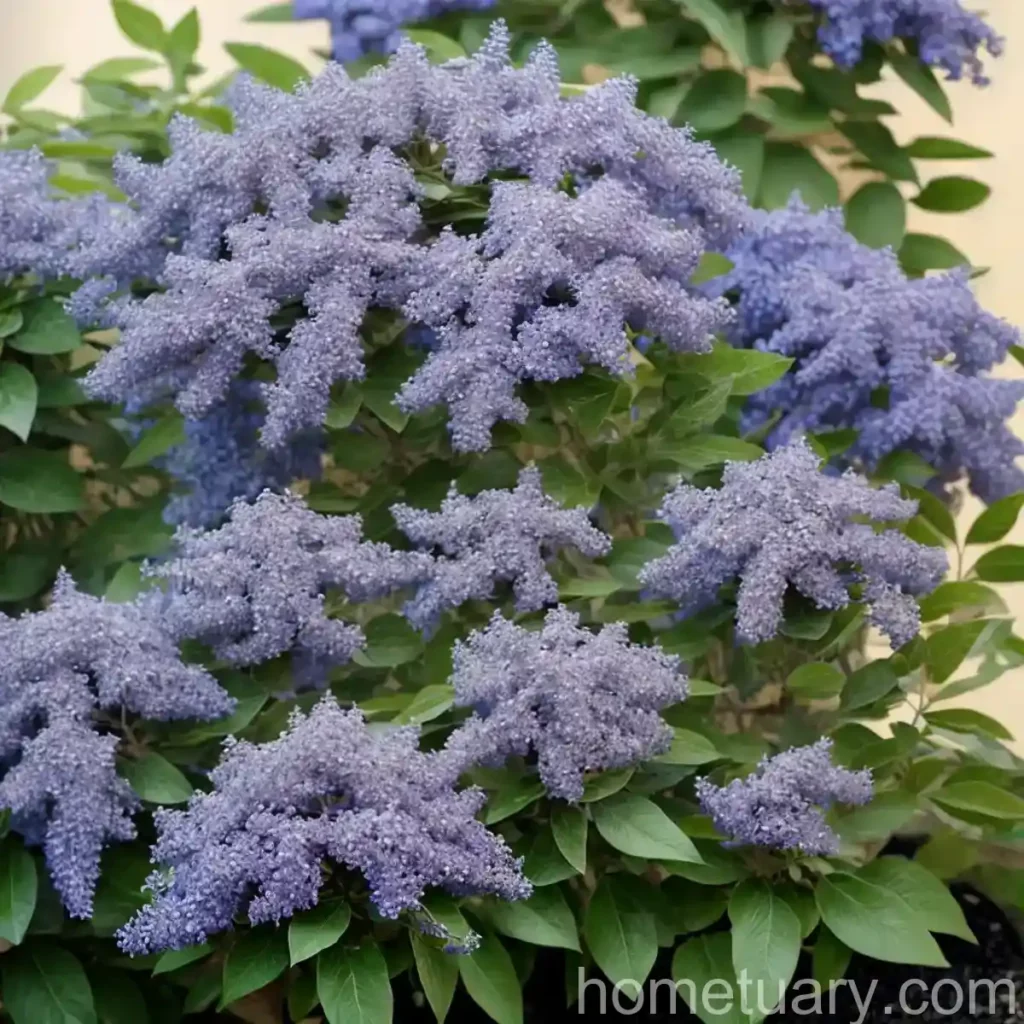California Lilac (Ceanothus x delileanus ‘Gloire de Versailles’): A Complete Guide
Ceanothus x delileanus ‘Gloire de Versailles,’ commonly known as California lilac, is a beautiful and versatile shrub that’s perfect for a variety of landscaping purposes. With its stunning blue flowers, evergreen foliage, and adaptability to various soil and climate conditions, this plant has become a popular choice among gardeners and landscapers. In this comprehensive guide, we will explore everything you need to know about the California lilac, from its cultural requirements and uses to its propagation and common diseases.
What is the California Lilac?
The California lilac, also known by its botanical name Ceanothus x delileanus ‘Gloire de Versailles,’ is a hybrid shrub that belongs to the buckthorn family, Rhamnaceae. It is a cross between two Ceanothus species, Ceanothus coeruleus and Ceanothus americanus. The resulting hybrid, Ceanothus x delileanus, exhibits a combination of desirable traits from both parent plants, making it a valuable addition to gardens and landscapes.
The ‘Gloire de Versailles’ variety specifically is celebrated for its vibrant, deep blue flowers and its ability to thrive in a range of environmental conditions. The term “Gloire de Versailles” translates to “Glory of Versailles” in French, which aptly captures the beauty and elegance of this particular cultivar.
Key Takeaways – California Lilac (Ceanothus x delileanus ‘Gloire de Versailles’)
Before we delve into the detailed aspects of cultivating and caring for the California lilac, let’s highlight some key takeaways about this remarkable plant.
- Scientific Name: Ceanothus x delileanus ‘Gloire de Versailles’
- Common Names: California lilac, Versailles glory plant
- Family: Rhamnaceae
- Uses: Landscaping, soil erosion control, wildlife habitat
- Characteristics: Evergreen, vibrant blue flowers, drought-tolerant
- Cultural Requirements: Full sun, well-drained soil, minimal water needs
Cultivation and Care
To successfully grow and maintain California lilacs, it’s crucial to understand their specific cultural requirements. From sunlight and water needs to soil types and pruning techniques, every aspect of caring for these plants plays a vital role in their overall health and vibrancy.
Uses
California lilacs are valued for their ornamental characteristics and their ability to serve practical purposes in landscaping and environmental conservation. Consider the following uses when incorporating the ‘Gloire de Versailles’ variety into your garden or landscape:
-
Ornamental Beauty: The vibrant blue flowers of the California lilac make it a stunning addition to any garden. Its evergreen foliage provides year-round interest, while its dense growth habit creates a lush and attractive appearance.
-
Soil Erosion Control: The extensive root system and dense growth of California lilacs make them effective in stabilizing soil on slopes and hillsides, thus reducing erosion rates.
-
Wildlife Habitat: The flowers of California lilacs attract pollinators such as bees, butterflies, and hummingbirds, adding life and movement to the garden while providing essential resources to local wildlife.
Water
One of the most appealing features of California lilacs, including the ‘Gloire de Versailles’ variety, is their remarkable drought tolerance once established. However, proper watering is crucial, particularly during the establishment phase.
-
Establishment Period: Newly planted California lilacs need regular watering to help them establish a strong root system. Provide approximately 1 inch of water per week during the first year, ensuring that the soil remains consistently moist but not waterlogged.
-
Mature Plants: Once established, California lilacs are remarkably resilient to drought. In most cases, they will only require supplemental watering during prolonged periods of extreme dryness.
Sunlight
California lilacs, including the ‘Gloire de Versailles’ cultivar, thrive in full sun conditions. Adequate sunlight is essential for promoting healthy growth and abundant flowering.
-
Sun Exposure: Plant your California lilac in a location where it will receive at least 6 to 8 hours of direct sunlight each day. Insufficient sunlight may result in reduced flowering and overall vigor.
-
Orientation: When selecting a site for planting, aim to provide the shrub with ample sunlight throughout the day, especially during the morning and early afternoon hours.
Fertilizer
While California lilacs are generally adaptable and do not have intensive fertilization needs, providing some supplemental nutrients can support their overall health and growth.
-
Timing: Fertilize California lilacs in early spring, just before the onset of new growth. This will ensure that the plant has access to essential nutrients as it begins its active growth phase.
-
Fertilizer Type: Use a balanced, slow-release fertilizer designed for flowering shrubs, applying it according to the manufacturer’s instructions. Avoid excessive nitrogen, as this can promote excessive vegetative growth at the expense of flowering.
Soil
California lilacs, including the ‘Gloire de Versailles’ variety, are relatively adaptable to different soil types, provided that the soil is well-draining.
-
Preferred Soil: Plant California lilacs in well-drained, slightly acidic to neutral soil. They are tolerant of a range of soil textures, including sandy, loamy, and rocky soils.
-
Soil Amendments: If your soil is heavy and poorly draining, consider amending it with organic matter such as compost or well-rotted manure to improve its drainage and fertility.
Pruning
Pruning is a valuable practice for maintaining the shape, size, and overall health of California lilacs. Additionally, proper pruning can encourage better flowering and promote a more compact growth habit.
-
Pruning Time: Prune California lilacs, such as the ‘Gloire de Versailles’ cultivar, immediately after the flowering period. This typically occurs in late spring to early summer. Avoid pruning in fall or winter, as this may inadvertently remove flower buds.
-
Pruning Technique: Remove dead, damaged, or diseased branches first, followed by any crossing or congested branches. Aim to maintain a balanced and open growth habit to allow adequate air circulation and light penetration.
Propagation
While established California lilacs are relatively low-maintenance, propagating new plants from existing specimens can be a rewarding endeavor. There are several methods of propagation that can be used to create new California lilac plants, including:
-
Seed Propagation: Propagating California lilacs from seed is a straightforward but time-consuming process. Collect ripe seeds in the fall and sow them in a prepared seed bed. Germination may take several months, and the resulting seedlings may exhibit genetic variation.
-
Softwood Cuttings: Softwood cuttings, taken from actively growing shoots in spring or early summer, can be successfully rooted to produce new California lilac plants. Use a rooting hormone to encourage the development of roots on the cuttings, and provide a warm and humid environment to support their growth.
-
Layering: Air layering or simple layering can be used to encourage the development of roots on a branch while it is still attached to the parent plant. Once roots have formed, the layered section can be severed from the parent plant and transplanted as a new specimen.
Container Popularity
California lilacs, including the ‘Gloire de Versailles’ variety, are well-suited to container cultivation, making them a popular choice for courtyard gardens, balconies, and patios.
-
Container Size: Select a large, sturdy container with ample drainage holes. California lilacs have extensive root systems and will benefit from a spacious container to accommodate their growth.
-
Soil Mix: Use a well-draining potting mix formulated for woody plants, ensuring that the container provides adequate aeration and moisture retention.
-
Sunlight: Place the container in a location that receives full sunlight for the majority of the day. Rotate the container periodically to promote even growth on all sides of the plant.
Common Diseases and Pests
While California lilacs, including the ‘Gloire de Versailles’ variety, are relatively resistant to pests and diseases, they may occasionally encounter issues that can impact their health and appearance. Understanding these potential challenges and knowing how to address them is essential for maintaining robust and thriving plants.
Disease Diagnosis
Several common diseases can affect California lilacs. Recognizing the symptoms of these diseases is crucial for implementing timely and effective management strategies. Some of the most prevalent diseases include:
-
Powdery Mildew: This fungal disease appears as a white or gray powdery coating on the leaves, stems, and flowers. It can lead to distorted growth and reduced plant vigor.
-
Ceanothus Leaf Spot: This bacterial disease causes circular, brown spots to form on the leaves. Severe infections can result in defoliation and a decline in overall plant health.
-
Root Rot: Root rot, caused by various soil-borne pathogens, can affect California lilacs if they are planted in excessively wet or poorly drained soil. Symptoms include wilting, yellowing foliage, and a general decline in plant health.
Common Pests
While California lilacs are relatively resistant to pests, they may still attract some common insect visitors. Being vigilant and proactive can help prevent these pests from causing extensive damage to the plants. Some notable pests include:
-
Aphids: These small, soft-bodied insects feed on the sap of new growth, causing distorted leaves and a sticky substance known as honeydew. They can also transmit viral diseases to the plant.
-
Scale Insects: Scale insects can appear as small, waxy bumps on the stems and undersides of leaves. They feed on plant sap and can weaken the plant over time.
-
Caterpillars: Certain caterpillar species may feed on the leaves of California lilacs, leading to defoliation and reduced plant vigor. Handpicking caterpillars or using biological control methods can help manage their populations.
Botanist’s Tips
As a plant scientist and enthusiast, I have gathered several tips for successfully growing and enjoying California lilacs, particularly the ‘Gloire de Versailles’ variety. These insights are designed to enhance your experience with these beautiful shrubs and promote their long-term health and vitality.
-
Mulching: Apply a layer of organic mulch around the base of California lilacs to conserve soil moisture, suppress weeds, and regulate soil temperature. Avoid placing mulch in direct contact with the plant’s stem or trunk.
-
Minimal Pruning: While regular pruning is beneficial, particularly for shaping and rejuvenating the plant, aim to minimize excessive pruning to avoid stimulating vigorous growth at the expense of flowering.
-
Tolerant of Neglect: Once established, California lilacs, including the ‘Gloire de Versailles’ cultivar, are remarkably resilient and can withstand periods of neglect, making them suitable for low-maintenance landscapes.
-
Attracting Pollinators: To enhance the wildlife-friendly nature of California lilacs, consider planting other native flowering plants nearby to attract a diverse array of pollinators to your garden.
Fun Facts
Here are some fascinating and fun facts about California lilacs and the ‘Gloire de Versailles’ variety that showcase the unique characteristics and appeal of these plants:
-
The deep blue flowers of the ‘Gloire de Versailles’ variety are reminiscent of the clear, sunny skies of California, making them a symbol of beauty and resilience in the garden.
-
In their native habitats, California lilacs play a vital role in supporting local biodiversity by providing essential resources to pollinators and serving as habitat for various small creatures.
-
California lilacs are celebrated for their ability to thrive in challenging environments, making them a valuable asset for sustainable and resilient landscaping designs.
-
The ‘Gloire de Versailles’ cultivar is known for its adaptability and robust nature, making it a top choice for gardeners seeking low-maintenance and visually striking plants.
Links to External Resources
Here are some additional resources and references for further exploring the California lilac (Ceanothus x delileanus ‘Gloire de Versailles’) and related topics:
-
The Royal Horticultural Society – Ceanothus x delileanus ‘Gloire de Versailles’
-
University of California Agriculture and Natural Resources – California Native Plant Landscaping
In conclusion, the California lilac, specifically the ‘Gloire de Versailles’ variety, exemplifies the beauty, resilience, and environmental adaptability of this cherished plant species. Whether you’re drawn to its stunning blue flowers, its value as a wildlife-friendly plant, or its capacity to thrive in diverse settings, the California lilac holds a special place in the world of horticulture and landscaping. By understanding and implementing the cultural recommendations presented in this guide, you can enjoy the exceptional qualities of the California lilac in your own garden or landscape, contributing to its continued popularity and significance in horticultural practices.
Remember, the ‘Glory of Versailles’ may originate in its name, but its true glory is in the joy and beauty it brings to our gardens and landscapes.
Happy gardening!















